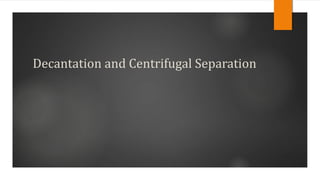
Decantation and Centrifugal Separation Techniques
- 1. Decantation and Centrifugal Separation
- 2. Contain INTRODUCTION DECANTATION SEPARATION CENTRIFUGAL SEPARATION DIFFERENCE IMPORTANT TIP 1. 2. 3. 4. 5.
- 3. Introduction of Separation A separation process is a method that converts a mixture or a solution of chemical substances into two or more distinct product mixture. In some cases, a separation may fully divide the mixture into pure constituents. Separations exploit differences in chemical properties or physical properties (such as size, shape, mass, density, or chemical affinity) between the constituents of a mixture. In this presentation we talking about two separation method; 1. Decantation Separation 2. Centrifugal Separation
- 4. Decantation Separation Decantation is a process that separates components of a mixture based on differences in density. Decantation involve two steps: 1. Sedimentation: Sedimentation uses gravity or a centrifuge to separate mixture components based on density. 2. Decanting: Decanting is pouring or siphoning off the top component of a mixture or daring the bottom component. Theory
- 5. What is Decantation? Decantation is a process for the separation of mixture of mixtures of immiscible liquids or of a liquid and a solid mixture such as a suspension. An incomplete separation is witnessed during the separation of two immiscible liquids, Working Principle The basic principle of decantation is the heavier (denser) substances sink, while lighter (less dense) substances float. In its simplest form, decantation uses gravity to separate a solid and liquid or two immiscible liquids. The lighter component is poured or siphoned off the top of the mixture.
- 6. Uses of decantation Decantation can be used to separate immiscible liquids that have different densities. For example, when a mixture of water and oil is present in a beaker, a distinct layer between the two consistency is formed, with the oil layer floating on top of the water layer. Common example 1. Oil and Vinegar 2. Oil and Water 3. Kerosene and water Equipment
- 7. Oil floats on top of water. After letting a mixture of oil and water sit, the oil can be poured off of the water. In a separatory funnel, the water can be drained away from the oil. Decantation is one way to clean muddy water. Soil and debris sinks to the bottom, so clear water is poured off. Decanting water isn’t sufficient to completely purify it because some particles (like bacteria and viruses) are too light to sink with the dirt. Other particles dissolve in water (like heavy metals and pesticides). Even after decantation, other method are needed to produce drinking water, like filtration or distillation. The kerosene or gasoline floats above the water. Decanting this liquid is dangerous because the fuel evaporates to from flammable, toxic fumes. Decantation separates cream from milk. Cream rises to the liquid and is easily skimmed off. Examples
- 8. Centrifugal Separation Centrifugation is the process that uses centrifugal force for the separation of two liquids in a mixture. In this process, the denser component of the mixture migrates away from the axis and the lighter component migrates towards the axis. Example : Let us understand this process with the example of milk are rotated, the heavier milk is pulled outward against the wall, whereas, the lighter cream is collected in the middle. Both the components are then collected separately. Theory
- 9. Working Principle A centrifuge operates by using the sedimentation principle: liquids separate according to their density under the influence of gravitational force (g-force). Various forms of separation, including isopycnic, ultrafiltration, gradient of mass, phase separation, and pelleting, are known. Types of Centrifugation For splitting ions, there are two types of centrifugal techniques; 1. Differential centrifugation 2. Centrifugation of density gradients It is further possible to separate density gradient centrifugation into rate-zonal and isopycnic centrifugation.
- 10. Centrifuge A centrifuge is a system that separate the component parts of a liquid or fluid (and even gases) using centrifugal force. This is done b rotating the fluid in a bottle at high speed, thereby separating fluids of varying densities (e.g. milk cream) or liquids from solids. Uses of centrifuge A centrifuge is a laboratory instrument that is used, depending on mass, to isolate gases, gas or liquid. By rotating a vessel carrying material at high speed, separation is accomplished; the centrifugal force forces heavier materials to the outside of the vessel. Low speed High speed Ultra speed
- 11. Centrifugation separation of solid substances from highly concentrated suspensions Separation of oily concentrated sludge Separation of oily suspensions Separation of heavy particles and large sized grains by cycloning Main Applications
- 12. Difference Decantation Decanting allows two immiscible liquids of a mixture of solid and liquid to separate out by gravity. Once the mixture components have separated, the lighter liquid is poured off leaving the heavier behind. It is not very accurate as a small amount of the lighter is always left behind. Centrifugation In a centrifugation is the process that used centrifugal force to separate various component of fluid. A centrifuge is used to spin mixtures of solids and liquids very fast so that the solid gravitates the bottom and the liquid to the top.
- 13. For a more accurate method of purification, centrifugation and decantation are used together; you use the centrifuge to separate the solid and the liquid then decant the liquid off the top, however a small amount of the liquid is always left behind. Important for this topic